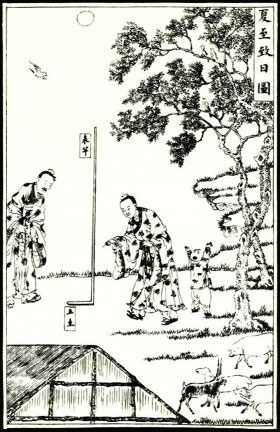
Helmer Aslaksen insegna "matematica celeste e astronomia culturale" all'università di Singapore ed ha scritto una pubblicazione intitolata "La matematica del calendario cinese", ma anche un saggio breve: "Quando cade il nuovo anno cinese".
Si parte dalla regola empirica che il capodanno dovrebbe essere la luna nuova più vicina all'inizio di primavera ("lichun"), ma questa regola fallisce se il lichun cade esattamente in mezzo a due lune nuove (è avvenuto nel 1985 e avverrà di nuovo nel 2015). Si parte da qui per approfondire date e strumenti e approdare al ciclo sessagenario ("gan zhi") che deriva dalla combinazione del ciclo decennale degli elementi e quello dei dodici segni dello zodiaco.
"chinese astronomer determining summer solstice" @ Maths of chinese calendar
Add new comment